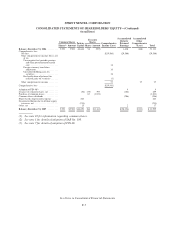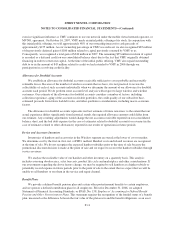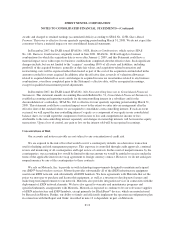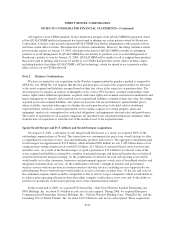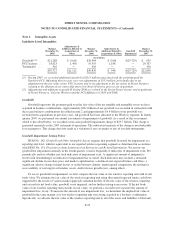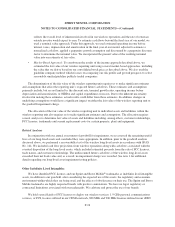Sprint - Nextel 2007 Annual Report Download - page 100
Download and view the complete annual report
Please find page 100 of the 2007 Sprint - Nextel annual report below. You can navigate through the pages in the report by either clicking on the pages listed below, or by using the keyword search tool below to find specific information within the annual report.SPRINT NEXTEL CORPORATION
NOTES TO CONSOLIDATED FINANCIAL STATEMENTS—(Continued)
from the date of the Sprint-Nextel merger on a straight-line basis. We also evaluate the remaining useful lives of
our definite lived intangible assets each reporting period to determine whether events or circumstances warrant a
revision to the remaining periods of amortization, which would be addressed prospectively.
We review our long-lived intangible asset groups for impairment under the same policy described above for
property, plant and equipment, that is, whenever events or changes in circumstances indicate that the carrying
amount may not be recoverable. Impairment analyses, when performed, are based on our current business and
technology strategy, our views of growth rates for our business, anticipated future economic and regulatory
conditions and expected technological availability. In addition, when our annual goodwill test requires us to
determine the implied fair value of our goodwill, we also evaluate the recorded value of our long-lived assets for
impairment.
Derivative Instruments and Hedging Activities
We recognize derivative instruments as either assets or liabilities in our consolidated balance sheets and
measure those instruments at fair value in accordance with SFAS No. 133, Accounting for Derivative Instruments
and Hedging Activities, as amended. Changes in the fair value of derivatives are recorded each period in current
earnings or other comprehensive income (loss) depending on the use of the derivative and whether it qualifies for
hedge accounting.
We use derivative instruments only for hedging and risk management purposes. Hedging activity may be
done for purposes of mitigating the risks associated with an asset, liability, committed transaction or probable
forecasted transaction. We are primarily exposed to the market risk associated with unfavorable movements in
interest rates, equity prices and foreign currencies. We do not enter into derivative transactions for speculative or
trading purposes.
At inception and on an on-going basis, we assess whether each derivative that qualifies for hedge accounting
continues to be highly effective in offsetting changes in the cash flows or fair value of the hedged item. If and
when a derivative instrument is no longer expected to be highly effective, hedge accounting is discontinued.
Hedge ineffectiveness, if any, is included in current period earnings.
We formally document all hedging relationships between the hedging instrument and the hedged item as
well as our risk management objectives and strategies for undertaking various hedge transactions.
Treasury Shares
Shares of common stock repurchased by us are recorded at cost as treasury shares and result in a reduction
of shareholders’ equity. We reissue treasury shares as part of our shareholder approved stock-based
compensation programs, as well as upon conversion of outstanding securities that are convertible into common
stock. When shares are reissued, we determine the cost using the weighted average cost method. If the
re-issuance of the shares is for an amount greater than the original cost of the treasury shares, we record an
increase to paid-in capital for the excess. If the re-issuance is for less than the original cost of the treasury shares,
we record a decrease to paid-in capital or retained earnings (accumulated deficit) for the shortage.
Revenue Recognition
Operating revenues primarily consist of wireless service revenues, revenues generated from handset and
accessory sales, revenues from wholesale operators and PCS Affiliates, as well as long distance voice, data and
Internet revenues. Service revenues consist of fixed monthly recurring charges, variable usage charges such as
F-15




